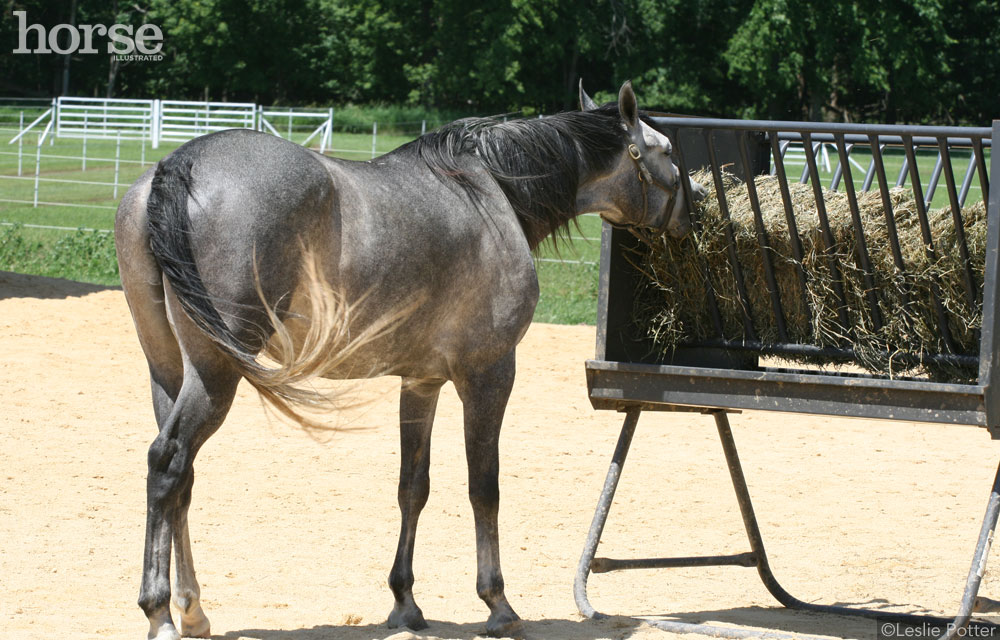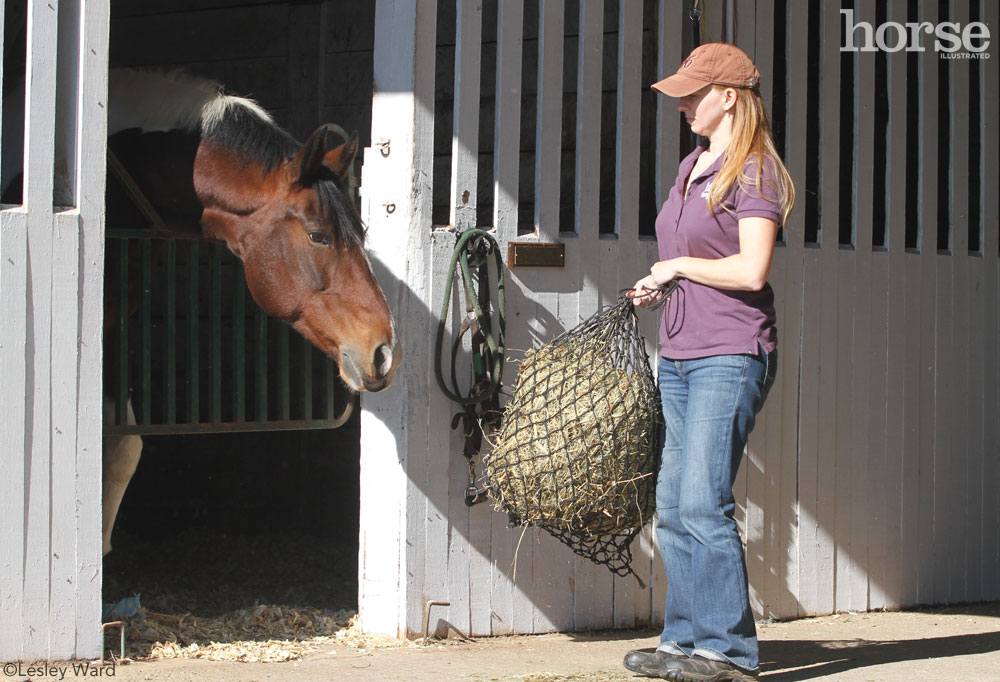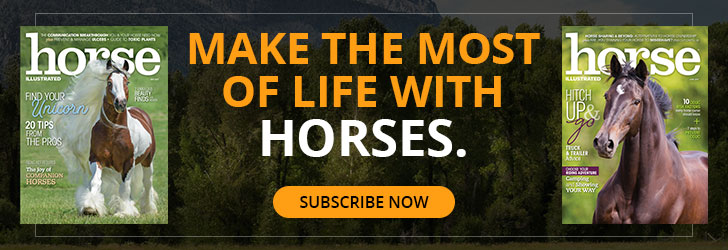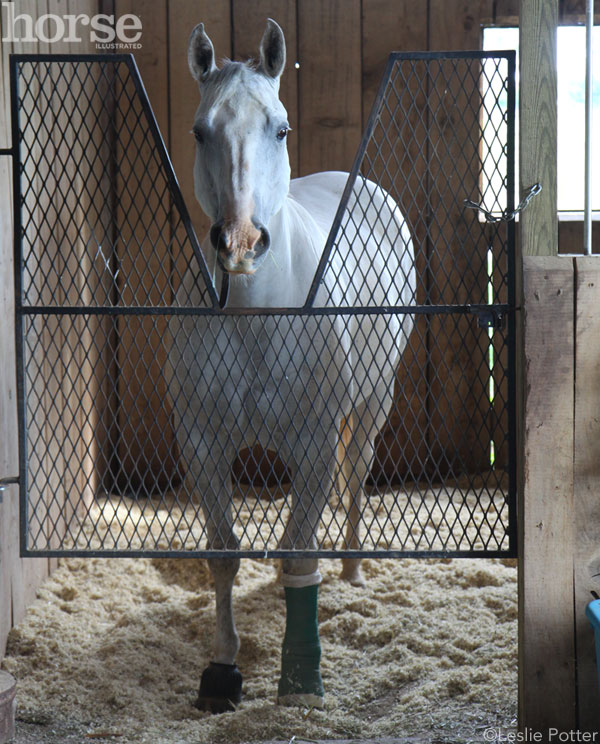Not all horses have the luxury of spending time out on green pasture, grazing to their heart’s content. Horse owners in some areas of the country are severely challenged by space or by climate, and their horses must be kept in a stall or turnout with sparse vegetation for most, if not all, of the day and night. Also, some horses simply can’t handle the lushness of green grass due to metabolic concerns and must be kept in confinement on a controlled diet.

The healthiest strategy for equine gastrointestinal health is the act of grazing at intermittent intervals throughout the day. We’ve all heard the wealth of information on how to best control gastric ulcers and behavioral problems: Turn the horse out and allow him to eat frequent, small meals throughout the day by grazing on pasture. So how do you accomplish this if pasture is in short supply?
Where to Start
When most horses are fed large amounts in two meals a day, they tend to bolt the food in a short time—an hour or two at most. Then they are forced to fast through the rest of the day or night until the next meal arrives. This is not at all how the equine digestive system was meant to work. To keep the digestive tract of a horse at its healthiest, he should receive 1 ½ to 2 percent of his body weight in roughage (fiber) each day when possible. Note that some horses are easy keepers and prone to obesity, while others have higher food requirements to maintain weight due to breed type, disposition and exercise demands.
Typical roughage sources come in the form of pasture, hay, or complete feed pellets. Alternative fiber sources are available (soybean hulls, beet pulp, rice hulls, corn cobs, chaff and straw). In general, the best approach is to provide roughage that accommodates a horse’s need to be a “trickle feeder,” eating small meals frequently.
Instead of being fed two to three relatively large meals in a 24-hour period, it’s better in all respects for a horse to be able to nibble periodically throughout the day and night. In a perfect world, you’d be able to offer free choice hay and your horse would control his intake, eating only as much as he needs to maintain perfect body condition. But some horses are gluttons and just won’t stop eating, thereby exceeding their optimal calorie allotment so much that they become obese.
Controlling Feed Intake
There is one useful method to slow down the voracious eaters: The use of a slow feeder or small-hole hay net. These feeding systems go by many names, but are either a container that is hung on the wall or a ground box or frame feeding system that forces a horse to work at getting hay out from between closely-knit netting or wire mesh. An alternative is to use one of the mesh sleeves that fit around a large bale of hay.
For some horses, you may need to double-bag the hay bale in a net feeder in order to reduce the mesh size and make it more challenging for the horse to extract the hay. Many commercial slow feeder options are built with 1½ to 2″ mesh, but some crafty horses may need it sized down to 1¼” or even 1″ mesh.
If you use a slow feeder bag or net, make sure the top closes tightly so the horse can’t pull large amounts out from the top but rather is forced to eat from the mesh openings only. For horses that have become quite good in eating from the mesh, if you hang the feeding bag from a breakaway rope so it isn’t braced against a firm surface, it’s harder for the horse to get a purchase on it, further slowing down the intake.
There are a plethora of these slow-feeder options that can be found online, including plans for making your own at a relatively inexpensive cost.
With any of these techniques, it takes a bit more effort for a horse to eat than if the hay is just thrown in loose flakes on the ground. By working around the mesh, it takes longer for the horse to acquire his food, somewhat similar to the process of grazing on pasture. This enables you to control his groceries and calories so he is fed the appropriate amount each day, and then doesn’t go through as long of a fasting period between refills.
The slow-feeding systems can be used to supplement whatever little pasture you may have, or they can be used as a total dietary source of roughage.

Horses in Motion
One of the key benefits to having horses on pasture is that they will wander and walk many miles each day. One study showed that horses given pasture access for 17 hours per day walked 8 to 9½ miles over a 400-acre field, while those given just seven hours pasture access walked 2½ to 3 miles. This form of exercise is beneficial to musculoskeletal health and mental contentment as well as keeping muscle tone in good shape. Another study demonstrated an improvement in aerobic capacity in young Thoroughbreds by as much as 25 percent when turned out to pasture for 7 to 20 hours each day.
If pasture isn’t available, there should be some form of turnout even if there is no grass. It might help to scatter hay in many piles or in slow feeders throughout the paddock so horses have to move around and make an effort to seek out the food rather than standing in one place to eat.
Supplements for Non-Pastured Horses
One of the key ingredients that may be nutritionally deficient for horses that have no access to green grass is vitamin E. Without a sufficient intake of vitamin E, a horse can experience muscle, neurologic or immune system problems. In a Canadian study, horses that had pasture access in summer months had vitamin E concentrations in their plasma that were 63 percent higher than non-pastured horses that consumed only hay or pelleted feed during the same period. This is of concern for both young, growing horses as well as adult horses.
In addition, horses that are supplemented with high-fat diets to add calories may need supplementation with vitamin E as an antioxidant along with the fat.
It is also important to recognize that even a horse on seemingly lush, green pasture may be vitamin E deficient if there is over-utililzation of vitamin E and/or the horse is not able to appropriately absorb this vitamin. The vitamin E of choice to use as a supplement is d-alpha-tocopherol, a natural vitamin E that is readily absorbed.
Vitamin A (carotene) may also be inadequate if horses are fed older hay or hay that has lost its green color. Most commercial feeds contain ample vitamin A, so feeding some small amounts of pelleted feed should adequately supply this nutrient.
While not necessarily termed a deficiency, horses with limited access to pasture or forage may consume the dirt around them to appease their desire for fiber, leading to sand colic. There is great benefit to using pysllium treatment for six to seven consecutive days each month to help clear the intestines of ingested sand and dirt. Setting up feeding systems, like tractor tires turned inside out or feeding on rubber mats, helps to limit intake of sand and dirt.
Salt is an important dietary ingredient for any horse, regardless of whether he is pastured or lives on a dry lot. Provide a plain salt block that your horse can access. This is preferable to adding salt to the feed, as any excess salt is simply urinated away, providing more work for the kidneys. It helps to locate the salt lick out of the weather so rain doesn’t dissolve it.
Depending on the geographical location where your horse’s hay is grown, there may be a deficiency in selenium in the soil, leading to a deficiency in the hay. Check with your veterinarian before supplementing with selenium, as it can cause serious toxicity if over-supplemented.
In certain parts of the U.S., particularly the western states, drought often causes a hay shortage, or at the very least has a huge impact on horse owners’ wallets as demand for short supply escalates hay prices. Are there fiber-based products you can use to supplement hay? Tap here to read about forage alternatives.
This article originally appeared in the February 2015 issue of Horse Illustrated magazine. Click here to subscribe!




great info
Great tips. I feed my horses 4-5 times a day.
great info
Wow, that is alot of information for a person to remember. I will have to reread it. I guess, I am lucky to have my horses on pasture. But still, I like to learn there are other ways, if needed.